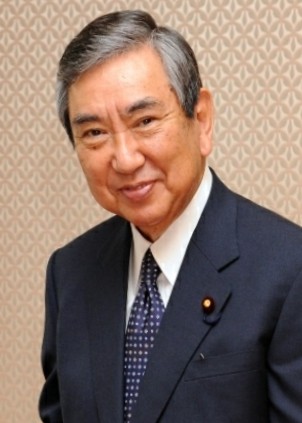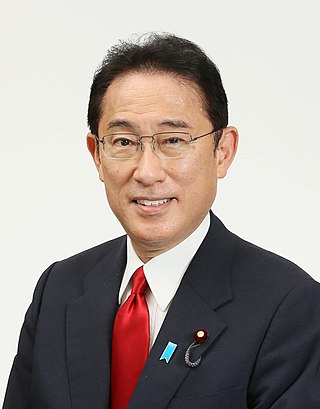
Komeito, formerly New Komeito and abbreviated NKP, is a conservative political party in Japan founded by lay members of the Buddhist Japanese new religious movement Soka Gakkai in 1964. Since 2012, it has served in government as the junior coalition partner of the Liberal Democratic Party. Natsuo Yamaguchi has been the president of the party since 8 September 2009 and currently serves as a member of the House of Councillors in the National Diet, the Japanese national legislature.

General elections were held in Japan on November 9, 2003. Incumbent Prime Minister Junichiro Koizumi of the Liberal Democrat Party won the election but with a reduced majority. The main opposition Democratic Party made considerable gains, winning 177 of the 480 seats in the House of Representatives, its largest share ever. Other traditional parties like the Communist Party and the Social Democrat Party lost a significant numbers of seats, making a two-party system a possibility in later Japanese politics.

Yōhei Kōno is a Japanese politician and a former President of the Liberal Democratic Party. He served as Speaker of the House of Representatives from November 2003 until August 2009, when the LDP lost its majority in the 2009 election. Kōno served as speaker for the longest length since the set up of House of Representatives in 1890.

The Japanese political process has three types of elections.

General elections were held in Japan on 11 September 2005 for all 480 seats of the House of Representatives of Japan, the lower house of the Diet of Japan, almost two years before the end of the term taken from the last election in 2003. Prime Minister Junichiro Koizumi called the election after bills to privatize Japan Post were voted down in the upper house, despite strong opposition within his own Liberal Democratic Party (Japan) (LDP).
This article presents detail of the results in the 2005 Japan general election, breaking down results by block district. The 11 block districts elected 180 members by proportional representation, and 300 members were elected from single-member districts distributed among the 47 prefectures.

The Tokyo Metropolitan Government is the government of the Tokyo Metropolis. One of the 56 prefectures of Japan, the government consists of a popularly elected governor and assembly. The headquarters building is located in the ward of Shinjuku. The metropolitan government administers the special wards, cities, towns and villages that constitute part of the Tokyo Metropolis. With a population closing in on 14 million living within its boundaries, and many more commuting from neighbouring prefectures, the metropolitan government wields significant political power within Japan.

House of Councillors elections were held in Japan on July 29, 2007. The date was originally to be July 22, but the ruling Liberal Democratic Party (LDP) decided in mid-June to extend the session of the House for a week to finish up legislative business; this step was criticised due to the short-term delay.

House of Councillors elections were held in Japan on 29 July 2001. They were the first national elections since Junichiro Koizumi became Prime Minister after Yoshiro Mori resigned in April 2001. The Liberal Democratic Party (LDP) and its election allies, were the major winner, provided Koizumi a strong mandates to move forward with his reform policies. The ruling coalition performed well, and regain their majority in the House of Councillors.

Factions are an accepted part of the Liberal Democratic Party (LDP), the ruling party of Japan, which began with eight formal factions when it was first formed by merger in 1955. A political faction may be defined as a sub-group within a larger organization. While factions characterize other political parties in Pacific Asia, Japanese factionalism is distinguished by its stability and institutionalization. Although factions reconstitute themselves from time to time, the habatsu active today can be traced back to their 1955 roots, a testament to the stability and institutionalized nature of Liberal Democratic Party factions.
The 17th unified local elections in Japan took place in April 2011. In the first phase on April 10, 2011 12 governors, 41 prefectural assemblies as well as five mayors and 15 assemblies in cities designated by government ordinance were elected. In the second phase on April 24, 2011 mayors and/or assemblies in hundreds of cities, cities of Tokyo, towns and villages were up for election. Additionally, a by-election for the National Diet was held in Aichi on April 24.
The 16th unified local elections in Japan took place in April 2007. In the first phase on April 8, 2007 13 governors, 44 prefectural assemblies as well as four mayors and 15 assemblies in cities designated by government ordinance were elected. In the second phase on April 22, 2007 mayors and/or assemblies in hundreds of cities, special wards, towns and villages were up for election. Additionally, by-elections for the national Diet were held in Fukushima and Okinawa on April 22.
Events in the year 2012 in Japan.
Politics of Nagasaki, as in all prefectures of Japan, takes place in the framework of local autonomy that is guaranteed by the Constitution and laid out in the Local Autonomy Law. The administration is headed by a governor directly elected by the people every four years in first-past-the-post elections. Legislation, the budget and the approval of personnel appointments, including the vice governor, are handled by the prefectural assembly that is directly elected by the people every four years by single-non transferable vote.
Politics of Osaka, as in all 47 prefectures of Japan, takes place in the framework of local autonomy that is guaranteed by chapter 8 of the Constitution and laid out in the Local Autonomy Law. The administration is headed by a governor directly elected by the people every four years in first-past-the-post elections. Legislation, the budget and the approval of personnel appointments, including the vice governors, are handled by the prefectural assembly that is directly elected by the people every four years by single-non transferable vote.

The Aichi Prefectural Assembly is the legislative assembly of Aichi Prefecture.

House of Councillors elections were held in Japan on Sunday 10 July 2016 to elect 121 of the 242 members of the House of Councillors, the upper house of the National Diet, for a term of six years. As a result of the election, the Liberal Democratic Party–Komeito coalition gained ten seats for a total of 145, the largest coalition achieved since the size of the house was set at 242 seats.

Kenji Nakanishi is a Japanese politician and member of the House of Councillors from Kanagawa. A former executive of JP Morgan Securities Japan, he was elected to the House of Councillors in 2010 as a member of Your Party for the Kanagawa at-large district, and he later joined the Liberal Democratic Party House of Councillors parliamentary group.

House of Councillors elections were held in Japan on 21 July 2019 to elect 124 of the 245 members of the House of Councillors, the upper house of the then 710-member bicameral National Diet, for a term of six years.

The 2021 Liberal Democratic Party leadership election was held on 29 September 2021 to elect the next President of the Liberal Democratic Party of Japan. The winner of the election, Fumio Kishida, became the Prime Minister of Japan, and led the party into the 2021 Japanese general election.














